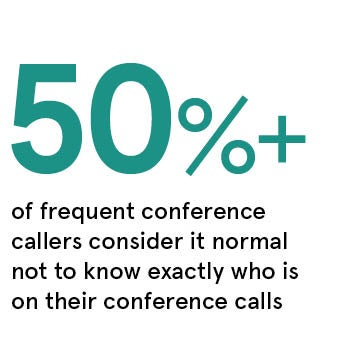Security breaches in the legal world are on the rise. According to PwC’s annual survey, 60 per cent of law firms reported a security incident in 2017.
While email, BYOD (bring your own device) and various technologies feature as areas of concern, any mention of conference calling tools, which are in constant use by legal teams for important client communications, is notably absent.
“Who just joined?” is perhaps the most-asked question ever on conference calls. This stems from the fact that most lawyers are still dialing in with phone numbers and access codes. They’re not using any software for a visual representation of who’s actually on their meeting calls.
 In a recent survey of 1,000 frequent conference callers commissioned by LoopUp, more than 50 per cent said they thought it was quite normal not to know exactly who’s on their calls. In confidential client meetings, this is troubling at best.
In a recent survey of 1,000 frequent conference callers commissioned by LoopUp, more than 50 per cent said they thought it was quite normal not to know exactly who’s on their calls. In confidential client meetings, this is troubling at best.
So why do most lawyers persist with dial-in? After all, the experience is rife with all too common frustrations such as not knowing who’s speaking, waiting for late joiners and dealing with distracting background noise.
Our minimalist interface is designed to guide users through an intuitive experience, with no training required
The answer lies in how people tend to adopt software. Very few work through a user guide. For most, it’s a process of trial and error over time. You test the waters by clicking a few things with mixed outcomes. Maybe you leave it for a while and come back to it. Maybe you ask a colleague for help. And over time, you end up either adopting it into regular use or you don’t.
But trial-and-error-based learning simply doesn’t play out well when it comes to remote-meetings software. As host, you’re live in the hot seat with multiple guests – clients, colleagues, counterparties. The last thing you want is for anything to go wrong. You just want something that works.
And so most lawyers do something very understandable, they default to the devil they know – dial-in. They may well not like it, but at least everyone can dial a phone number and punch in a code. It’s the safe play.
Plenty of feature-rich software products have tried to drag conferencing out of the dark ages. And they’ve had some success with tech-savvy early adopters and certain specialist user groups, such as IT and training teams. But none have managed to “cross the chasm” into the mainstream majority, who continue to play it safe with dial-in.
So are we doomed to a never-ending future of painful, insecure dial-in conferencing? Certainly not. At LoopUp, we’ve taken a contrarian approach to software design. Rather than trying to wow the tech savvy, LoopUp has been built very specifically for the mainstream majority. In the wider software world, this might be seen as foolhardy, but considering the risk-averse nature of the remote-meetings world, we think it’s essential if we are to entice them away from dial-in.
We don’t overwhelm users with features; we believe less is more when it comes to remote meetings. Our minimalist interface is designed to guide users through an intuitive experience, with no training required. We integrate with tools that businesses use every day, such as Outlook and focus on a reliable, high-quality experience throughout every call, in terms of both audio quality and visual context.
And it’s working. While our users may still dial in if they choose, 75 per cent of the time they forego it altogether, opting instead to have LoopUp call out to them on a phone of their choice. They’re then naturally guided to a webpage or mobile app where they can see who’s on the meeting and who’s speaking, with intuitive controls to add missing guests and mute background noise.
We’re working towards a world where dial-in fades into the background, bringing a new level of visibility and security to light.
Read the Enterprise Conferencing User Behaviour and Impact Report: www.loopup.com/legal-innovation




